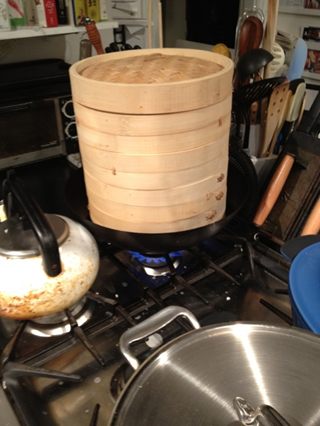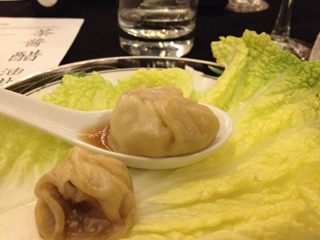A couple of people have asked for the Lapsong Souchong broth Soup Dumpling recipe.
It was our first time making Soup Dumpling and we learned a bunch. Our basic guide was Andrea Nguyen’s cookbook ASIAN DUMPLINGS. There is far more in there than I can reproduce here without feeling like a copyright infringer, so get the book from Ten Speed Press (2009) for the full rundown on the technique.
The main thing about the soup is that you are making it with agar-agar (or gelatin, if you can’t find agar agar) so that it is solid in the dumpling filling, but melts into a soup when the dumpling is steamed. The important trick with the dumpling dough is that when you roll it out, instead of making just a round flat skin, you just roll out the edges, leaving a thick-bottomed “belly” in the center which becomes the bottom of the dumpling.
Photos and broth recipe below the cut:
Lapsong Souchong Broth
corwin invented this some years ago after we’d eaten a meal at Restaurant L in Boston, one of the first upscale fine-dining places doing Asian Fusion after Ming Tsai’s Blue Ginger. They served us thin shaved beef and brought an iron teapot of broth that they poured at he table over the meat, cooking it instantly. corwin adapted the idea but made up this broth with actual tea in it for a much better effect!
Lapson souchong is the tea that already tastes like smoke. That and ginger, plus perhaps a pinch of fine spice powder are the main flavorings other than whatever meat stock you are using. In the case of Duck Day, we used duck stock.
Here’s a variation using canned beef broth, though, easy to do at home:
BEEF LAPSANG BROTH
1.5 cups beef broth (or stock, if stock add salt to taste)
3 slices ginger
1 scallion, loosely chopped
1 clove garlic, smashed
1 pinch five spice powder
1/2 cup lapsong souchong tea leaves
1/2 teaspoon agar-agar (or 1.5 teaspoon gelatin)
Put the broth, ginger, scallion, garlic, and five-spice powder into a sauce pan and simmer until reduced by half. Remove from heat, then put in the tea leaves while still hot and let them steep for for minutes. Strain immediately and squeeze what you can out of the tea leaves back into the pot.
Top up the liquid amount now to 2/3 cup (if it’s below that amount). Put it back in the pot and sprinkle in 1/2 teaspoon powdered agar-agar, or if you don’t have that you can do it with 1 1/2 teaspoon unflavored gelatin. Bring it to a boil, then pour it into an 8×8″ baking pan and refrigerate for an hour (or overnight) so that it’s solidified.
Cut it into fine cubes to add to the filling.
The filling can be any of the usual wonton or dumpling fillings. Ground meat, mushrooms, scallions, leeks… I’m now game to try all of them. The main thing is you mix this with the little cubes of solidified soup. We found that if we chopped the cubes finer, we had a better distribution of soup from dumpling to dumpling.
The ratio for this amount of gelled soup goes with about 1/2 pound of ground meat.
Dumpling skins are basically flour, water, and oil and you can do it in the food processor. You really need to read Andrea’s book on the nitty gritty of rolling them out, though. Looking online I found a lot of places that said buy dumpling wrappers not wonton wrappers, but I’ve been in dozens of Asian markets and I never recall seeing dumpling wrappers. (Maybe you can only tell that’s what they are if you read one of the asian languages printed on the package?) I’d be willing to try it with round wonton wrappers just to save time but I haven’t run that experiment yet.
Tips:
Ngyuen’s book says to line the bamboo steamer lined with parchment paper. If I do it again I’ll leave out the paper and use napa cabbage leaves instead. Some of the dumplings stuck to the paper, and a few broke and we lost their soup. In cabbage leaves we wouldn’t have the sticking problem and the soup would still be sitting there. Also I think the loose leaves will let more steam through to the upper baskets (we were steaming 3 layers at once).
Funnily enough, we steamed some leaves by themselves to put on the serving plates, but it would’ve made more sense to do them under the dumplings to begin with. Duh. Live and learn.
I used to think I could get through life without a bamboo steamer basket by just using the steamer plate in my rice cooker. I was wrong. Bamboo steamers are awesome and magical and if you buy them at the Asian market they are dirt cheap as well. Since we bought ours and can’t believe we lived without it, basically.



Thanks for posting this! I’ve been longing to try these for a while – we have very little good/authentic Chinese food in my hometown, but I’m headed to San Francisco next month, where I plan to seek out soup dumplings. Between that and this, I hope to get the nerve to try making my own.
Pressing and rolling out the dough was a little labor intensive, but it worked! I was pretty happy with how they came out. Really made me appreciate what the restaurants that do it well go through, though.